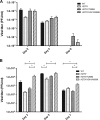Impact of potential permissive neuraminidase mutations on viral fitness of the H275Y oseltamivir-resistant influenza A(H1N1)pdm09 virus in vitro, in mice and in ferrets
- PMID: 24257597
- PMCID: PMC3911590
- DOI: 10.1128/JVI.02681-13
Impact of potential permissive neuraminidase mutations on viral fitness of the H275Y oseltamivir-resistant influenza A(H1N1)pdm09 virus in vitro, in mice and in ferrets
Abstract
Neuraminidase (NA) mutations conferring resistance to NA inhibitors (NAIs) generally compromise the fitness of influenza viruses. The only NAI-resistant virus that widely spread in the population, the A/Brisbane/59/2007 (H1N1) strain, contained permissive mutations that restored the detrimental effect caused by the H275Y change. Computational analysis predicted other permissive NA mutations for A(H1N1)pdm09 viruses. Here, we investigated the effect of T289M and N369K mutations on the viral fitness of the A(H1N1)pdm09 H275Y variant. Recombinant wild-type (WT) A(H1N1)pdm09 and the H275Y, H275Y/T289M, H275Y/N369K, and H275Y/V241I/N369K (a natural variant) NA mutants were generated by reverse genetics. Replication kinetics were performed by using ST6GalI-MDCK cells. Virulence was assessed in C57BL/6 mice, and contact transmission was evaluated in ferrets. The H275Y mutation significantly reduced viral titers during the first 12 to 36 h postinfection (p.i.) in vitro. Nevertheless, the WT and H275Y viruses induced comparable mortality rates, weight loss, and lung titers in mice. The T289M mutation eliminated the detrimental effect caused by the H275Y change in vitro while causing greater weight loss and mortality in mice, with significantly higher lung viral titers on days 3 and 6 p.i. than with the H275Y mutant. In index ferrets, the WT, H275Y, H275Y/T289M, and H275Y/V241I/N369K recombinants induced comparable fever, weight loss, and nasal wash viral titers. All tested viruses were transmitted at comparable rates in contact ferrets, with the H275Y/V241I/N369K recombinant demonstrating higher nasal wash viral titers than the H275Y mutant. Permissive mutations may enhance the fitness of A(H1N1)pdm09 H275Y viruses in vitro and in vivo. The emergence of such variants should be carefully monitored.
Figures




References
-
- WHO 2012. Review of the 2011-2012 winter influenza season, northern hemisphere. Wkly. Epidemiol. Rec. 87:233–240 http://www.who.int/wer/2012/wer8724.pdf - PubMed
-
- CDC 2013. Influenza activity—United States, 2012-13 season and composition of the 2013-14 influenza vaccine. MMWR Morb. Mortal. Wkly. Rep. 62:473–479 http://www.cdc.gov/mmwr/preview/mmwrhtml/mm6223a5.htm - PMC - PubMed
Publication types
MeSH terms
Substances
Grants and funding
LinkOut - more resources
Full Text Sources
Other Literature Sources
Medical

